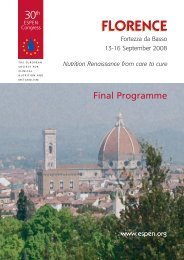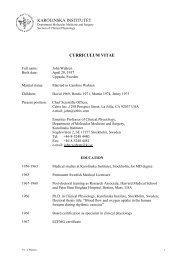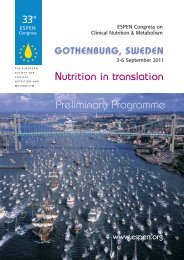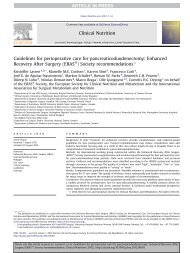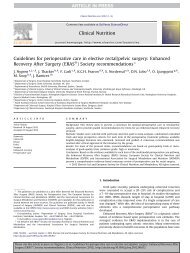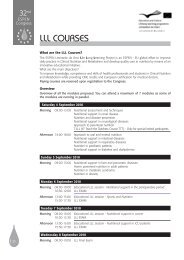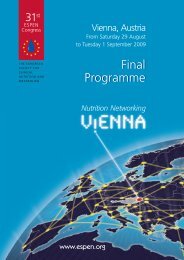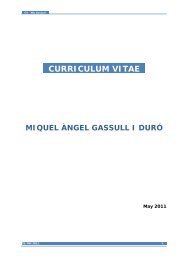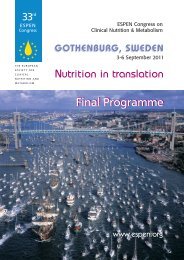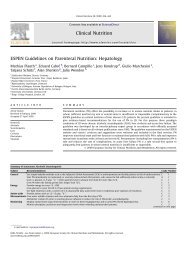Bioelectrical impedance analysisFpart I: review of principles ... - espen
Bioelectrical impedance analysisFpart I: review of principles ... - espen
Bioelectrical impedance analysisFpart I: review of principles ... - espen
You also want an ePaper? Increase the reach of your titles
YUMPU automatically turns print PDFs into web optimized ePapers that Google loves.
Introduction<br />
This <strong>review</strong> discusses the application <strong>of</strong> bioelectrical<br />
<strong>impedance</strong> analysis (BIA). BIA is widely used<br />
in many clinical situations. Part 1 is a <strong>review</strong> <strong>of</strong> the<br />
<strong>principles</strong> and methods <strong>of</strong> BIA, the body compartments<br />
evaluated with BIA, selection criteria, and<br />
selected BIA equations reported in the literature.<br />
Part II will provide guidelines for BIA use in clinical<br />
practice.<br />
Historical background<br />
Electrical properties <strong>of</strong> tissues have been described<br />
since 1871. 1 These properties were further<br />
described for a wider range <strong>of</strong> frequencies on<br />
larger range <strong>of</strong> tissues, including those that were<br />
damaged or undergoing change after death.<br />
Thomasset 2,3 conducted the original studies using<br />
electrical <strong>impedance</strong> measurements as an index <strong>of</strong><br />
total body water (TBW), using two subcutaneously<br />
inserted needles. H<strong>of</strong>fer et al. 4 and Nyboer 5 first<br />
introduced the four-surface electrode BIA technique.<br />
A disadvantage <strong>of</strong> surface electrodes is<br />
that a high current (800 mA) and high voltage<br />
must be utilized to decrease the instability <strong>of</strong><br />
injected current related to cutaneous <strong>impedance</strong><br />
(10 000 O/cm 2 ). 6 By the 1970s the foundations<br />
<strong>of</strong> BIA were established, including those that<br />
underpinned the relationships between the <strong>impedance</strong><br />
and the body water content <strong>of</strong> the body.<br />
A variety <strong>of</strong> single frequency BIA analyzers then<br />
became commercially available, and by the 1990s,<br />
the market included several multi-frequency<br />
analyzers. The use <strong>of</strong> BIA as a bedside method<br />
has increased because the equipment is portable<br />
and safe, the procedure is simple and noninvasive,<br />
and the results are reproducible and<br />
rapidly obtained. More recently, segmental BIA<br />
has been developed to overcome inconsistencies<br />
between resistance (R) and body mass <strong>of</strong><br />
the trunk.<br />
ARTICLE IN PRESS<br />
<strong>Bioelectrical</strong> <strong>impedance</strong> analysis 1227<br />
<strong>Bioelectrical</strong> spectroscopy;<br />
ESPEN guidelines;<br />
Fat-free mass;<br />
Total body water;<br />
Extracellular water;<br />
Intracellular water;<br />
Body cell mass<br />
The determination <strong>of</strong> changes in body cell mass (BCM), extra cellular (ECW) and<br />
intra cellular water (ICW) requires further research using a valid model that<br />
guarantees that ECW changes do not corrupt the ICW. The use <strong>of</strong> segmental-BIA,<br />
multifrequency BIA, or bioelectrical spectroscopy in altered hydration states also<br />
requires further research.<br />
ESPEN guidelines for the clinical use <strong>of</strong> BIA measurements are described in a paper<br />
to appear soon in Clinical Nutrition.<br />
& 2004 Elsevier Ltd. All rights reserved.<br />
Principles <strong>of</strong> bioelectrical <strong>impedance</strong><br />
The resistance (R) <strong>of</strong> a length <strong>of</strong> homogeneous<br />
conductive material <strong>of</strong> uniform cross-sectional area<br />
is proportional to its length (L) and inversely<br />
proportional to its cross sectional area (A)<br />
(Fig. 1). Although the body is not a uniform cylinder<br />
and its conductivity is not constant, an empirical<br />
relationship can be established between the <strong>impedance</strong><br />
quotient (Length 2 /R) and the volume <strong>of</strong><br />
water, which contains electrolytes that conduct the<br />
electrical current through the body. In practice, it<br />
is easier to measure height than the conductive<br />
length, which is usually from wrist to ankle.<br />
Therefore, the empirical relationship is between<br />
lean body mass (typically 73% water) and height 2 /<br />
R. Due to the inherent field inhomogeneity in<br />
the body, the term height 2 /R describes an equivalent<br />
cylinder, which must be matched to the<br />
real geometry by an appropriate coefficient. This<br />
coefficient depends on various factors, among them<br />
also the anatomy <strong>of</strong> the segments under investigation.<br />
Therefore, errors occur when there are<br />
alterations in resistivity <strong>of</strong> the conductive material,<br />
Current<br />
Cylinder<br />
Length (L)<br />
Crosssectional<br />
area (A)<br />
Figure 1 Principles <strong>of</strong> BIA from physical characteristics<br />
to body composition. Cylinder model for the relationship<br />
between <strong>impedance</strong> and geometry. The resistance <strong>of</strong> a<br />
length <strong>of</strong> homogeneous conductive material <strong>of</strong> uniform<br />
cross-sectional area is proportional to its length (L) and<br />
inversely proportional to its cross sectional area (A).<br />
Hence resistance ðRÞ ¼rL=A ¼ rL 2 =V; and volume ðVÞ ¼<br />
rL 2 =R; where r is the resistivity <strong>of</strong> the conducting<br />
material and V equals AL.



